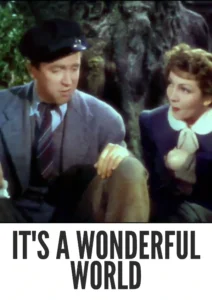Contact: info@alwanfilm.com
Video Sources 0 Views
- Watch trailer
- It's a Wonderful World


Synopsis
Table of Contents
ToggleReview: It’s a Wonderful World 1939 Colorized – A Heartwarming Comedy Enriched with Early Color

Introduction
“It’s a Wonderful World” (1939) stands as a testament to the enduring charm of classic comedy and the timeless appeal of heartwarming storytelling. In this review, we’ll explore the significance of this early colored film and its enduring legacy in the realm of cinematic entertainment.
Check The Full Colorized Movies List
Check Our Colorized Movies Trailer Channel
Understanding It’s a Wonderful World 1939 Colorized: Director, Cast, and Genre
Directed by W.S. Van Dyke, “It’s a Wonderful World” (1939) showcases his knack for crafting lighthearted comedies that resonate with audiences of all ages. The film features a talented cast led by the incomparable James Stewart and the effervescent Claudette Colbert, whose on-screen chemistry lights up the screen with laughter and warmth. Blending elements of romance, comedy, and drama, “It’s a Wonderful World” (1939) transports viewers to a world where anything is possible and every obstacle is an opportunity for adventure.
Exploring the World of It’s a Wonderful World 1939 Colorized: Plot and Characters
At its core, “It’s a Wonderful World” (1939) follows the misadventures of a bumbling private detective, played by James Stewart, and a spirited poetess, portrayed by Claudette Colbert, who find themselves embroiled in a web of intrigue and mistaken identity. As they navigate a series of comedic mishaps and madcap escapades, they discover that love and laughter can conquer even the most daunting challenges. Along the way, they encounter a colorful cast of characters who add depth and dimension to their whimsical journey.
The Art of Film Colorization
Film colorization serves as a transformative tool that enhances the visual experience of classic movies, breathing new life into timeless stories and captivating audiences with vibrant hues. By digitally adding color to black and white films, colorization allows viewers to immerse themselves in the rich tapestry of cinematic worlds, exploring every nuance and detail with fresh eyes and renewed appreciation.
Early Colored Films: A Brief History
The history of colored films traces its roots back to the early days of cinema, with filmmakers experimenting with various techniques to add color to their creations. From hand-tinted frames to early Technicolor processes, the evolution of colored film has been marked by innovation and ingenuity, paving the way for the development of modern colorization techniques that continue to captivate audiences to this day.
It’s a Wonderful World 1939 and Its Early Colored Version
The decision to release “It’s a Wonderful World” (1939) in a colorized format was met with both excitement and trepidation. While some welcomed the opportunity to experience the film in vibrant color, others expressed concerns about the potential impact on its visual aesthetic. Nevertheless, the early colored version of “It’s a Wonderful World” (1939) offers viewers a fresh perspective on the timeless tale of love and laughter, enhancing its comedic charm and captivating audiences with its luminous beauty.
The Debate Over Film Colorization
The debate over film colorization continues to divide audiences and critics alike, with proponents praising its ability to breathe new life into classic movies and introduce them to a new generation of viewers, while detractors argue that it compromises the artistic integrity of the original work and diminishes its historical significance. As the debate rages on, filmmakers and audiences alike are left to ponder the merits and drawbacks of colorization in the ever-evolving landscape of cinema.
Examining It’s a Wonderful World 1939 as an Early Colored Film
As with any colorized classic, the impact of colorization on “It’s a Wonderful World” (1939) is a matter of personal interpretation. Some may argue that it enhances the film’s visual appeal and immerses viewers in its world, while others may feel that it detracts from the timeless charm of the original black and white version. Regardless of one’s stance on the issue, there’s no denying the enduring power of “It’s a Wonderful World” (1939) as a heartwarming comedy that continues to bring joy and laughter to audiences around the world.
Influence and Legacy: It’s a Wonderful World 1939 Colorized’s Impact on Cinema
“It’s a Wonderful World” (1939) has left an indelible mark on the world of cinema, inspiring countless filmmakers and captivating audiences with its timeless tale of love and laughter. From its unforgettable performances to its witty dialogue and charming characters, the film continues to resonate with viewers of all ages, reaffirming its status as a beloved classic of the comedy genre.
Director’s Cinematic Legacy: Beyond It’s a Wonderful World 1939 Colorized
W.S. Van Dyke’s influence extends far beyond “It’s a Wonderful World” (1939), with a diverse body of work that continues to captivate audiences around the globe. From “The Thin Man” to “San Francisco,” Van Dyke’s films are celebrated for their wit, charm, and sophistication, solidifying his legacy as one of the preeminent directors of Hollywood’s Golden Age. Through his groundbreaking work, Van Dyke has left an indelible imprint on the world of cinema, inspiring generations of filmmakers to follow in his footsteps.
Themes Explored in It’s a Wonderful World 1939 Colorized
“It’s a Wonderful World” (1939) explores a myriad of themes, from the transformative power of love to the importance of laughter and friendship in times of adversity. Through its delightful characters and whimsical storytelling, the film invites viewers to embrace the joy of living and the magic of human connection. As audiences immerse themselves in the world of “It’s a Wonderful World” (1939), they are reminded of the simple pleasures that make life worth living and the enduring power of laughter to heal the soul.
Reception and Controversy Surrounding It’s a Wonderful World 1939 Colorized
Upon its release, “It’s a Wonderful World” (1939) received widespread critical acclaim, with many praising its charming performances, witty humor, and uplifting message. However, the decision to release the film in a colorized format sparked debate among purists, reigniting the age-old discussion surrounding film preservation and artistic integrity. Despite the controversy, “It’s a Wonderful World” (1939) remains a beloved classic that continues to bring joy and laughter to audiences of all ages, reaffirming its status as a timeless masterpiece of the comedy genre.
Where to Watch It’s a Wonderful World 1939 Colorized Online
For those eager to experience the timeless magic of “It’s a Wonderful World” (1939), the film is readily available on popular streaming platforms such as Netflix, Amazon Prime, and Hulu. Whether you choose to watch it in its original black and white format or the early colored version, “It’s a Wonderful World” (1939) promises to whisk you away on a delightful journey filled with laughter, love, and unforgettable moments.
FAQs About It’s a Wonderful World 1939 Colorized
Q: Is “It’s a Wonderful World” (1939) based on a true story? A: No, “It’s a Wonderful World” (1939) is a fictional comedy that follows the adventures of a bumbling private detective and a spirited poetess as they navigate a series of comedic mishaps and madcap escapades.
Q: Who are the main actors in “It’s a Wonderful World” (1939)? A: “It’s a Wonderful World” (1939) features an ensemble cast led by the talented James Stewart and Claudette Colbert, whose delightful performances bring the film’s whimsical characters to life with charm and wit.
Q: What awards did “It’s a Wonderful World” (1939) win? A: While “It’s a Wonderful World” (1939) did not win any major awards, it received critical acclaim for its charming performances, witty humor, and uplifting message.
Q: Why was “It’s a Wonderful World” (1939) released in a colorized format? A: The decision to release “It’s a Wonderful World” (1939) in color was made to introduce the film to a new generation of viewers and enhance its visual appeal for modern audiences. While the choice to colorize the film sparked debate among purists, it ultimately allowed “It’s a Wonderful World” (1939) to reach a wider audience and ensure its continued relevance in the annals of cinematic history.
Conclusion
“It’s a Wonderful World” (1939) remains a timeless classic that continues to delight audiences with its charming characters, witty humor, and heartwarming message. Whether viewed in its original black and white format or the early colored version, the film serves as a joyful reminder of the simple pleasures of life and the enduring power of laughter to uplift the spirit. So, whether you’re a longtime fan or discovering it for the first time, take a moment to experience the magic of “It’s a Wonderful World” (1939) and let its delightful characters and whimsical storytelling brighten your day.











